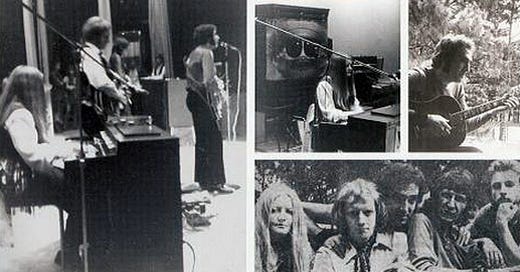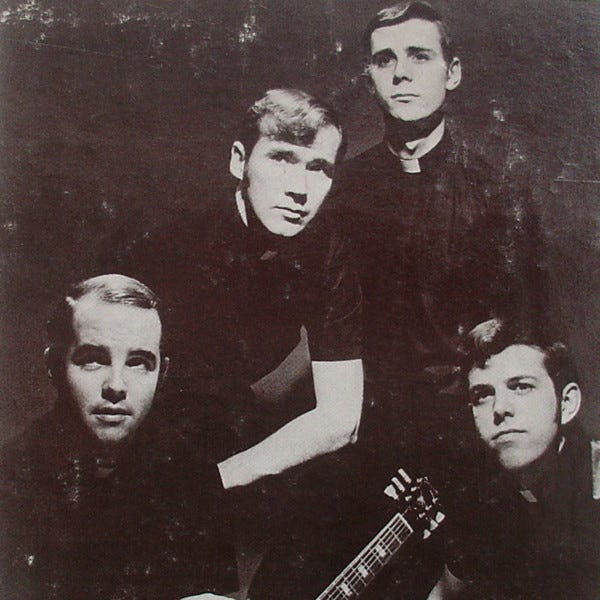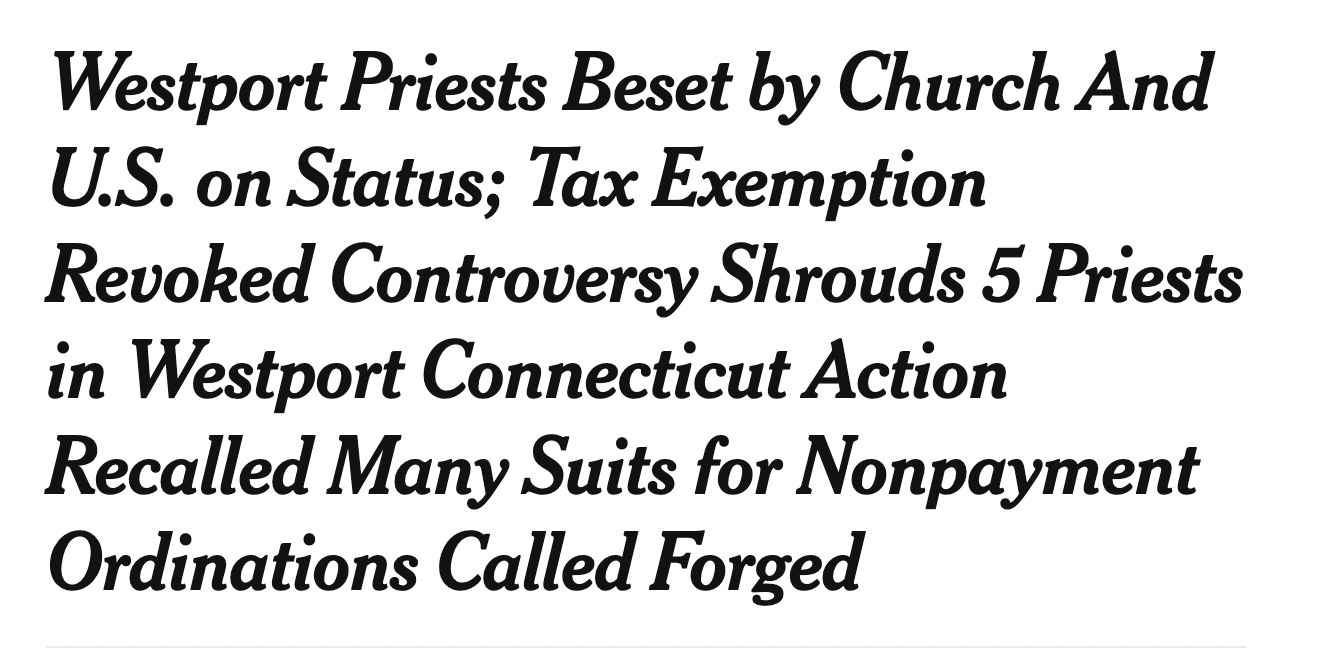006: The Story of Father Patrick J. Berkery and the Contemporary Mission, Inc., Part One
Plus The Third Eye and new music from Mary Jester
This week, before I get into this week’s extra-long special feature on the 30 year history of a group of beatnik Catholic priests who ran a record label/seminary/press/possible embezzling front, I want to highlight the latest offerings from local artist-musician-jack-of-all-trades Mary Jester:
Mary Jester - “You Caught Me In The Mirror” and “Dicey”
Following 2020’s “Feast Your Eyes” (video dir. by Liz Walber!), and a sampler of delectable singles over the years, Mary Jester is back with two lush tracks.
This new pair — expansive “You Caught Me In the Mirror” and meditative “Dicey” — highlight the full breadth of a remarkable musician. Looking closely at any one aspect of Mary’s musicmaking — as a singer, composer, producer, beatmaker, or performer — impresses, but her skill in all of them certifies her an absolute POWERHOUSE. From the deconstructed dance/techno stylings of ‘Boyfright Masterclass’ to haunting neon ballads like ‘Squeaky Boards’, it is clear that Mary’s projects have never simply made music, but instead have drawn attention to and dissected the components of what makes music, reassembling them in consistently exciting and pleasing ways.
Complementing her operatic vocal range and delivery with a tapestry of rich electronic textures and whimsical sonic augmentations, Mary Jester has refined a distinct, engaging blend of baroque, avant-garde, digital, and synth pop. It has been incredible to witness Mary's growth as an artist over the five (?) years I've gotten to listen to her music and see her perform, and it’s a joy to see that artistry shine in these exciting new tracks. I’m thrilled by the rumor there’s an album in the works, and I’m sure you are, too. Go Mary!
And, before our look into Father Pat Berkery, one requisite progressive rock record:
The Third Eye - “Awakening” (1969)
Not a lot of South African music made it through to the United States and Europe, in large part due to individual, governmental, and union boycotts of South African culture in response to Apartheid. In the case of The Third Eye, one might wonder if the band would have achieved widespread success internationally had their music circulated more widely, or, in South Africa, had their music been less lyrically critical of Apartheid. Awakening, in addition to The Third Eye’s other two records, Brother and Searching, very much aligns with the slightly rougher, low-budget heavy prog of the late 60s/early 70s that draws heavily from psychedelic and garage stylings and production. At the same time, the records are driven by a consistently strong and cohesive organ presence.
All the more impressive then that the organist of The Third Eye was Dawn Selby, the 14-year-old kid sister of lead guitarist Ron Selby! Particularly in Awakening, not only does the younger Selby’s organ playing keep up with the rest of the band, it holds the group together and propells it forward. Loose, laid-back tracks like “The Valley of Sadness” infuse gritty psychedelica with a distinct melodic composition and sophistication, while the more straightforward garage numbers like “Snow Child” and “Magic Hankerchief” offer an exciting interjection of sunshiney pop aesthetics onto the rougher edges of garage rock.
As always, hear more in this folder.
And now for the main event…
It began as just a look for more information about this first record, but quickly expanded into an epic odyssey about a group of counter-cultural Roman Catholic priests, their ridiculous commercial output, and their decades of legal drama:
Deep Dive: Father Pat Berkery and the Contemporary Mission
Prayers For A Noonday Church (1969)
The Catholic Church has spent the bulk of the 20th Century through the present day struggling to stay relevant in an increasingly secular world. Although some people (like me) believe the Church should have eschewed appeals to the masses (no pun intended) and stayed beautifully obtuse the way it was before Vatican II so we could still have the Tridentine Mass and more prominent lives of the saints and all the things that makes Catholicism strange and cool… in the early 1960s the Vatican instead changed everything in a desperate attempt to “update” the church and safeguard against the threat of Catholics leaving convents and seminaries in droves.
Prayers For A Noonday Church, on a smaller scale, is one such desperate attempt to appeal to youth. Backed by the psychedelic renditions of hymns by a St. Louis-based band called Spur, Father Patrick J. Berkery of New York, later Connecticut, offers strange, rambling beat-poetry sermons in an unbreaking monotone.
Who Was Father Pat?
Entranced by this oddity, I did some more research into Father Pat, and boy did I uncover an interesting guy. Orphaned along with his eleven siblings, Father Pat was raised in a polio hospital in New York after contracting the disease at the age of one. There, he was raised and educated by nuns, sparking his initial interest in religion. Berkery claims he “did not enter the seminary until later in life”, although his obituary states he was ordained in February of 1956.
In addition to his priesthood, Berkery recieved a Ph.D. in the history of philosophy, and certification in pastoral counseling and sacred oratory, according to his author’s den site from ~2003, which also mentions his dog, Natasha. Author’s Den lists Berkery as the author of several self-published books from 2001-2002, among them religious titles such as Where is God? There He is! and God is Calling… Got a Minute? , as well as the self-help Don’t Be Sad, It’s Not Worth it! and the collection of short fiction, walk a mile in my shoes: gripping, real life stories, excerpted below:
A story is like a flower. It helps you remember. It helps you forget. You look at the flower closely and it makes you marvel at how minute and magical are its design and borders. You can capture a flower and ask that it dance lightly on your aching soul to make the pain go away. The flower will obey because flowers live to lighten your load, to distract by their scent and beauty, letting you move in total abandonment towards the direction of your choice.
On his own work, Berkery writes:
walk a mile in my shoes: gripping real life stories is about life and its meaning. The pages of this book carry some powerful lessons that can benefit the reader beyond any expectations. Father Pat has taken the fiction of the story and put unique messages in its place. He uses the story as a dynamic vehicle that can capture our attention, hold it and then allow us to savor the story in a realistic setting. What is even more, Father Pat shows us how to empower ourselves through earnest stories. This is a book about life and its slippery slope. It is also a book about challenge, daring and do. You will find characters within that you can sympathize with as well as characters you would like to call "friend". But more importantly, the stories are stepping-stones to a richer, more rewarding life.
But do not let this kindly late-in-life ouevre conceal a much stranger character and more colorful body of work!
The Rite of Exorcism (1974)
First and foremost, Prayers for a Noonday Church was not Berkery’s only musical output. The 1974 album The Rite of Exorcism is ascribed to Rev. Patrick J. Berkery, PhD., a play telling the story of a young girl’s excorcism across three tracks: “The Story (Part 1)”, “The Story (Part 2)”, and “The Story (Part 3)”, with interspersed sung prayers and chants. The record ends with “Ron Aimee Fugue” a cheery piano- and organ-driven disco outro beginning with the words: “What you’ve just experienced is true,” detailing that everyone involved is “just fine” and “the town has returned to a normal existence”.
The album cover bears Berkery’s name and in the gatefold he is credited with the original concept, “Theological And Liturgical Research”, and the liner notes — which take the form of an acrostic prose poem that spells out “EXORCISM”. Also credited, with musical arrangement and production, is John O’Reilly, a frequent collaborator of Berkery’s.
The album is one of only three LPs and a handful of singles released by Crunch Records, which was “founded in 1973 by the Contemporary Mission, a group of Catholic priests” and headquartered in Westport, CT. The Catholic priests of the Contemporary Mission were none other than O’Reilly, Berkery, and two other reverends — all members of the Catholic missionary garage rock band, The Mission Singers.
The Contemporary Mission
The Contemporary Mission, Inc., in addition to producing records, dabbled also in publishing books beginning in the 1970s, many written by Berkery. The first collaboration I could find between the two took place after Prayers for a Noonday Church but before Contemporary Mission, when Berkery and O’Reilly co-authored a book called A New Catholic Cathecism (1970) that proposed “incorporating progressive perspectives” into mass.
A nonprofit called “The Montfort Mission” was first incorporated in Missouri in March of 1968, just one year before Berkery’s first record, backed by a St. Louis band, was released. Just a few months later, it was swiftly renamed The Contemporary Mission. Annual reports from the susequent two years list the non-profit’s character of affairs as first “Providing missionary religious work for the poor” in 1969, then in 1970, as a “seminary for Roman Catholic priesthood”, an “intercity apostalate”, and a “communications apostalate”. Also in 1970, Rev. Joseph Valentien and the other priests from the Mission incoporate another non-profit, this one called “The Contemporary City School” which aims to “provide an alternative school program for school children who are unable to achieve in the normal school system.”
The Mission fails to report in 1971 and is found delinquent, and Berkery doesn’t re-file until over a full year later in 1972. The Contemporary City School re-files in 1971 before going delinquent in 1972, after which there are no records until its forfeiture in 1982. It is during 1972 that the Mission embarks on its first legal battle, in Connecticut District Court.
In The Robert Stigwood Group Limited et al. v. John T. O’Reilly et al., decided on July 25, 1972, O’Reilly and the Contemporary Mission are sued for infringing copyright by holding “pirate” performances of Andrew Lloyd Webber’s Jesus Christ Superstar. The case briefing provides a more succinct biography of the priests’ background:
During 1971, the Mission Singers also manage to release five records called Disco Teach Albums (1-5), which are musically quite underwhelming, but I really like them.
The Mission’s nonprofit licensing is forfeited in 1974 due to a lack of filing, before being reinstated in 1975, this time with all five priests listed as living at the same address in Westport, CT: 285 Saugatuck Avenue, an enormous waterfront mansion.
Through 1976, the mission of the Missouri nonprofit is “to provide missionary, religious work and communication for the poor and needy”, but in 1977 it shifts to “activities relating to its apostolate in communications, education, self-development & other improvement programs by means of music, books, publishing, recording, improvement programs and associated endeavors.” It is also during 1976-77 that Contemporary Mission embarks on its second legal battle, against Famous Music Corporation.
Virgin: The Lost Rock Opera
Contemporary Mission, Inc. v. Famous Music Corporation, argued in New York District Court, reviews a contract dispute between Fr. O’Reilly and the head of Famous, Tony Martell, distributor of the rock operas Tommy and Jesus Christ Superstar.
The relationship between Famous and Contemporary was considerably more harmonious in 1972 than it is today. At that time, Martell thought he had found, in VIRGIN, another TOMMY or JESUS CHRIST SUPERSTAR, and he was anxious to acquire rights to it. O'Reilly, who was encouraged by Martell's expertise and enthusiasm, had high hopes for the success of his composition.
The rock opera, Virgin, debuted in New York City in 1972, to a less than rave review beginning…
Only a benign, hut, unfortunately, shortsighted, faith could have brought a “rock opera” called “Virgin” into Philharmonic Hall for a showcase performance Wednesday night.
… and ending…
Considering the costs of a one‐shot presentation of this sort, “Virgin” may have to be placed right up there with “Dude” as one of the season's most disastrous show biz outings.
In December, a more kindly NYT reviewer wrote:
The message is admirable. It is only the delivery that is a little murky and amateurish. The story is that of a priest who falls in love with a nun and, not unexpectedly, has a few difficulties. This is reasonable enough. But the music is not specially interesting, the staging is not especially good, and the show will appeal most strongly to those who wonder about Roman Catholic priests and their celibacy. I think celibacy is wrong. But I suppose opinions could differ.
Nevertheless, Famous agreed to pay royalties to Contemporary for the masters and promote Virgin — about a priest who marries a nun — as well as to institute Crunch Records. In exchange, Contemporary agreed to deliver a whopping ten long-playing records and fifteen single records during the first year of the contract. The suit states that “Although neither VIRGIN nor its progeny was ever as successful as the parties had originally hoped” things carried on peacefully until Famous was sold to ABC Records, Inc. A lawyer for ABC told O’Reilly that they would have no further relationship with Contemporary, after which Contemporary filed the suit.
The court ruled in favor of Contemporary Mission, except that there would be a subsequent trial to determine the value of the damages, of which I could find no record.
After this legal battle, the output of the Contemporary Mission, Inc. took a strange turn towards fad diets, healing elixers, and lawsuits against the New York Times. Stay tuned for Part Two!
…What could possibly happen next?







Where could I find the second part of the story?